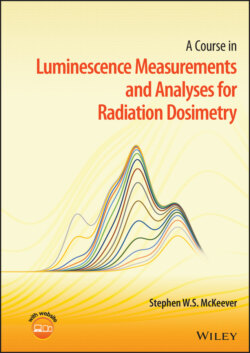Читать книгу A Course in Luminescence Measurements and Analyses for Radiation Dosimetry - Stephen W. S. McKeever - Страница 24
1.3.3 Space Dosimetry
ОглавлениеDosimetry (for astronauts and equipment) in space environments is one of the most challenging applications for luminescence dosimetry. The space environment consists of an extremely wide range of highly energetic charged particles originating from cosmic rays (CR), solar particle events (SPE), and the radiation belts trapped by the Earth’s magnetic field (Earth’s radiation belts, ERB). Additionally, once these particles interact with the spacecraft structures, the astronauts’ space suits, and the astronauts’ bodies, secondary charged particles and neutrons are also produced. Personal and environmental dosimeters for use in space therefore need to respond to an extremely wide-ranging set of particles, each with its own efficiency of luminescence production. The dosimeter’s response to each particle type needs to be well-known and calibrated.
TL dosimeters have been used since the beginnings of human space exploration, in both the American and former Soviet Union programs. More recently, OSL has been used in conjunction with TL in many international space programs. Neither TL nor OSL, however, is able to record dose over the wide range of charged-particle energies and types. The critical parameters are energy, charge, and the linear energy transfer (LET) of the particle. TLD and OSLD materials can record dose in fields of LET up to ~10 keV/μm with good efficiency. However, in space, particles of LET values of several hundred keV/μm can be expected. The efficiency of TLD and OSLD materials drops significantly as the LET increases beyond ~10 keV/μ m and, therefore, TLD and OSLD devices are usually used in conjunction with dosimeters such as particle nuclear track detectors (PNTDs), which can measure doses and fluences for individual particles up of these high-LET values, but are insensitive below ~5 keV/μm. Thus, techniques to separate the doses in these different regions of the LET spectrum have been devised and used for several years by the various international space agencies. An example of a personal dosimeter used by the US National Aeronautics and Space Administration (NASA) is shown in Figure 1.6 and features LiF:Mg,Ti TL dosimeters, Al2O3:C OSL dosimeters and PNTD using a polycarbonate plastic known as CR-39. RPLD using Al2O3:C,Mg may have a future application in space as a PNTD, at least as a research tool.
Figure 1.6 (a) NASA’s passive radiation area monitor (RAM), and (b) Radiation Area Monitor (RAM) and Crew Passive Dosimeter (CPD). Each consists of 20 TL dosimeters (LiF:Mg,Ti), two OSL dosimeters (Al2O3:C) and one PNTD (CR-39). In Figure 1.6a the TL dosimeters can be seen underneath the PNTD film, and the OSL dosimeters are inside the circular, black, Teflon holders. Source: NASA; reproduced with permission from NASA Export Control.
